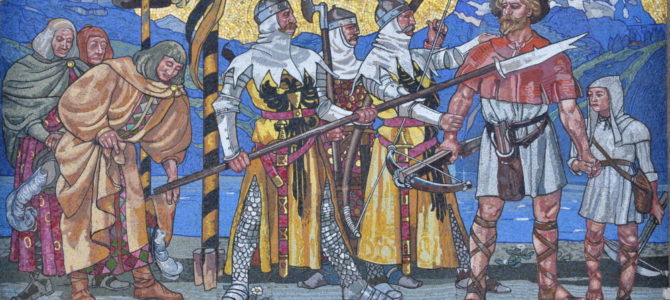
Most are familiar with the “William Tell Overture,” be it from the symphony or sporting events, Bugs Bunny or “The Princess Bride,” but less might remember the legend. That’s not shocking, as it’s about 700 years old now; but its relevance endures.
William Tell was a mountain-climbing Swiss man who, in the early 14th century, had the misfortune of traveling with his son through lands governed by Albrecht Gessler. Gessler was a bailiff of the Habsburg family, and eager to subdue the local populace.
One of his choice methods was daily humiliation, and to this end he had his hat raised up on a pole at the tree where the village’s justice and civil matters were traditionally decided. All passing by his hat were told in no uncertain terms they must bow before it — or face the consequences.
Tell was a strong and proud man, and he wasn’t interested in doing what the soldiers told him to do on that brisk day in late November 1307. He explained he would not be bowing to a hat, no matter the local ordinance. The soldiers didn’t like that very much, and besides, they had their orders, so they arrested Tell and his son and hauled them before the bailiff, who, you might imagine, enjoyed Tell’s stance on the hat even less than his men had.
Now our hero was a well-known crossbow marksman, so in theory he could be either a great friend or a terrible foe to Gessler, but the bailiff’s pride wouldn’t let him reason with a potential ally, so he ordered Tell to demonstrate his famous skills by shooting an apple off his son’s head in a single try. If the shot was true, they would go free; if not, both father and son would be executed.
Tell famously made the shot and the two were freed, but the bailiff had one more aching question: Why had the Swiss man drawn two bolts? Tell didn’t want to tell him, but under pressure he admitted he’d intended to kill the cruel bailiff had he hit his son or missed the shot. This enraged Gessler, but since he’d given his word to spare Tell’s life, he instead ordered him thrown in a dungeon for the rest of it.
The conclusion of the story is thrilling, and includes a shipwreck, a desperate countryside chase, a deadly ambush, and a national rebellion. But before its climax, in the cruel scenes that begin the legend, we might sense a familiar scene: A petty tyrant addicted to power and enacting arbitrary and capricious rules; common sense dispensed with, replaced with a sometimes self-destructive drive to maintain control through daily shame — even at the cost undercutting the original authority itself.
The bailiff’s ruthless crushing of dissent, which was unmoved by Tell’s completely understandable protectiveness of his child, also sounds familiar amid story after story of local school board fights, silenced microphones, threatened jobs, and struggling businesses closed by local magistrates.
There’s a reason the legend of William Tell has lived in our imaginations for 700 years: Every generation lives this story to one degree or another, and the concepts and ideals it illustrates don’t die with its characters.
Tell’s is a story more steeped in violence than the one we’re living today, thank goodness. The tyrant of his tale is quicker to capital punishment than the our modern leaders, but his methods are the same: He uses the child as a victim and pawn, and he silences the parent. His vindictiveness overwhelms even his own self-interest. He displays a willingness to wield all his authority and resources against even a single subject who questions even his stupidest rule.
Have you tried explaining how your child shouldn’t need to wear a mask in school lately? Or that teachers and other government employees should come back to work like the rest of us did long ago? Good luck. “Put on the mask. Bow to the hat. Or face your punishment.”
Our hero’s reaction is similarly violent, and their story ends differently than any school board or vaccine fight of 2021, but the themes are continuous as ever.
“I am fed to the teeth with elevated themes!” composer Wolfgang Amadeus Mozart complains in the great historical fiction “Amadeus.” “Old dead legends! Why must we go on forever writing about gods and legends?”
“Because they do,” the wise Baron Van Swieten swiftly replies. “They go on forever; or at least what they represent — the eternal in us.
Just as the story of William Tell lives on, so do cruel and petty leaders. If the pictures, videos and stories of citizen protests, rebellious teachers, fed-up cops, and angry parents across the country show anything, it’s that brave heroes live on as well. That’s a very good thing, but we need more of them.
According to the legend, Tell’s actions began alone and he bore them alone, threatened, imprisoned, wrecked and on the run; but his story ended joined by his neighbors in a national rebellion. He had exposed the leaders for who they were, and the people joined him in mass uprising, eventually leading to the birth of Swiss confederation, a precursor of modern Switzerland.
Our fight today is with different means in a different time, but the threat we face is no less existential. We are fighting for our future and our liberties; and the risks to our personal and professional relations, to our livelihoods, families and children, are very real.
Thank God America still has those like Tell, who are willing to stand up and say what’s right in the face of grave consequence. They can’t do it alone, though, and right now those brave men and women need the rest of us to stand behind them. It takes just a few to start a movement — it takes many more to see it through.









